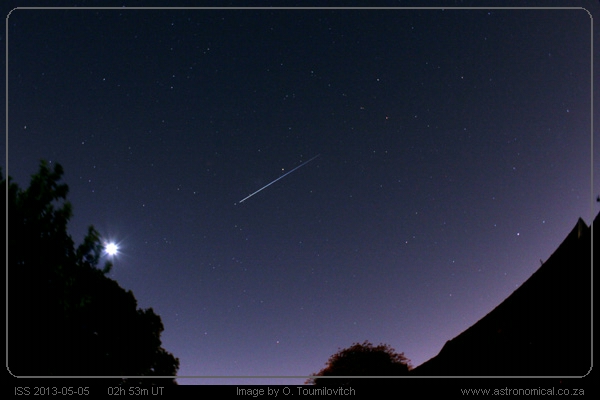|
Just as I was busy with the final camera settings at 05:51 a very bright fireball crossed the sky very close to where the ISS trail can be seen in this image, but.. I wasn't ready for it! Half an hour later, at 05:28 another smaller fireball burnt down right above me, leaving a wonderful greenish trail, illuminated by the moon (see the image below). Just in one hour I have seen three fireballs and few dozens of meteors, what a morning it was! Waking up at 4 am and going outside, where the temperature happened to be just two degrees above zero, was a very rewarding exercise. |
|
|
| |
|
|
| |
|
|
|
|
|
| |
I took my first ever photograph of the International Space Station on August 30th, 2009. Only 3.5 years later I finally caught the ISS transiting the Sun.
I had it all- random cloud obstructed the Sun just for 5 minutes exactly when the transit should have taken place back in 2009; I stuck in traffic on the way to the site in 2010 and arrived just 1 minute after the transit; I've left the camera adapter for the telescope at home in 2011; In 2012 I was ready in time, but it was a low transit, the ISS never showed up; another attempt failed when few minutes before the transit my telescope focussing mechanism just broke.
This time everything was just fine- the sky cleared up after rainy morning, the transit time, predicted by CalSky was accurate within a second, and I actually saw the ISS with my eye through the camera's vewfinder between the frames- it was spectacular!
More @ Spaceweather.com
High-res animation (3Mb) can be viewed HERE
|
|
| |
|
|
|
|
|
| |
I took my first ever photograph of the International Space Station on August 30th, 2009. Only 3.5 years later I finally caught the ISS transiting the Sun.
I had it all- random cloud obstructed the Sun just for 5 minutes exactly when the transit should have taken place back in 2009; I stuck in traffic on the way to the site in 2010 and arrived just 1 minute after the transit; I've left the camera adapter for the telescope at home in 2011; In 2012 I was ready in time, but it was a low transit, the ISS never showed up; another attempt failed when few minutes before the transit my telescope focussing mechanism just broke.
This time everything was just fine- the sky cleared up after rainy morning, the transit time, predicted by CalSky was accurate within a second, and I actually saw the ISS with my eye through the camera's vewfinder between the frames- it was spectacular!
More @ Spaceweather.com
High-res animation (3Mb) can be viewed HERE
|
|
| |
|
|
|
This was the only chance for me to photograph the Comet PanSTARRS from Johannesburg:

More images and reports at Comet PanSTARRS page |
|
|
| |
|
|
| |
|
|
|
For few days the Comet C/2012 F6 (Lemmon) presented a good photographic opportunity while appearing close to a bright globular star cluster Tucanae (47)
Visit our Comet LEMMON page for more info, images and reports

|
|
|
| |
|
|
| |
|
|
|
The sunset. As the Sun approaches the horizon, there is a lot happening with the sunrays before they reach our eyes or the camera. The rays of light are affected by many optical effects, such as absorption, reflection, refraction, abberration. And most of change is happening when the rays are travelling through the turbulent Earth's atmosphere.
|
|
|
| |
|
|
| |
|
|
|




















.jpg)
.jpg)
.jpg)